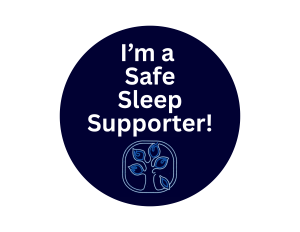
As your baby’s due date approaches, that urge to prepare everything for your baby's arrival becomes incredibly strong. While you're busy picking out adorable outfits and tiny shoes, remember one of the most crucial preparations: creating a safe sleep environment.
Safe sleep is an essential way to reduce the risk of Sudden Infant Death Syndrome (SIDS) and other sleep-related infant deaths. Let's go through a practical checklist to ensure your baby’s sleep space is as safe as possible, before you bring your baby home.
The foundation: The ABCS of safe sleep
Alone: Your baby should sleep alone in their own separate sleep space
Back: Always place your baby on their back for every sleep, day and night
Crib: Use a firm, flat, non-inclined sleep surface designed for infants (a crib, bassinet, or portable play yard)
Smoke-free: Your baby should be in a smoke-free environment
Find more about the ABCS of Safe Sleep here.
Your newborn sleep safety checklist
Check this list off to ensure you’re fully prepared for safe, peaceful sleep:
The sleep space
Infant-approved sleep surface: have you chosen a full-size crib, a bassinet, or a portable play yard (pack 'n play)?
Is it fully assembled according to manufacturer instructions, with all parts securely fastened?
A firm, flat mattress
Correct size: Can the mattress fit snugly in the crib/bassinet/play yard with no gaps larger than two fingers between the mattress and the frame?
Firmness: Is the mattress firm and flat, without any indentations or softness that could conform to your baby's head?
Fitted sheets
Quantity: Do you have at least 2-3 fitted sheets specifically designed for your mattress size?
Fit: Do they fit tightly and smoothly around the mattress without any loose fabric?
In the sleep space
Have you removed all pillows, loose blankets, quilts, comforters, and crib bumper pads?
Are all stuffed animals, toys, and other soft objects removed from the sleep area?
Wearable blankets/sleep sacks
Variety: Do you have 2-3 wearable blankets or sleep sacks in appropriate sizes and varying TOG (Thermal Overall Grade) ratings for different room temperatures?
Swaddles (and knowing when to stop): If planning to swaddle, be sure that you understand you must stop swaddling as soon as your baby shows any sign of rolling
Lightweight sleepwear
Basic layers: Do you have simple sleepers or onesies to dress your baby in under the sleep sack, appropriate for the ambient room temperature?
Avoid overheating: Can you dress your baby in no more than one layer more than you'd wear to be comfortable?
The sleep environment
Proximity: Have you designated a spot in your bedroom for the baby's separate sleep space, close to your bed but not in your bed?
Accessibility: Is it easy to reach your baby for feeding and comforting?
Can you maintain a comfortable temperature (ideally between 68-72°F or 20-22°C)?
Is the room well-ventilated, without drafts directly on the baby?
Is your home smoke-free, and will your baby be kept away from all sources of smoke?
Educating caregivers
Share guidelines: Have you discussed safe sleep practices with all potential caregivers, including grandparents, babysitters, and anyone else who will care for your baby?
Preparing for your newborn's arrival is an exciting journey. By putting safety first, especially when it comes to sleep, you're building a foundation for a healthy, happy start for your little one. With these preparations in place, you can welcome your baby with confidence and peace of mind.
About SIDS of Illinois, Inc.
Sudden Infant Death Services of Illinois, Inc., is a not for profit, 501(c)(3) organization dedicated to the prevention of sudden, unexpected infant death by providing educational programs to families, healthcare professionals, law enforcement, childcare providers, and the general public as well as bereavement services to families and any others who have experienced the tragedy of sudden, unexpected infant death. Donate here to become a Safe Sleep Supporter!
